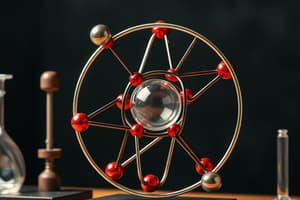Podcast
Questions and Answers
What do lower and uppercase symbols signify in isotopes?
What do lower and uppercase symbols signify in isotopes?
- Lowercase symbols signify heavy isotopes, while uppercase symbols indicate light isotopes.
- Lowercase symbols signify isotopes with high electronegativity, while uppercase symbols indicate low electronegativity isotopes.
- Lowercase symbols signify light isotopes, while uppercase symbols indicate heavy isotopes. (correct)
- Lowercase symbols signify isotopes with low melting points, while uppercase symbols indicate high melting point isotopes.
How are atoms represented in atomic notation?
How are atoms represented in atomic notation?
- By using their elemental symbol followed by the electron count.
- By using their atomic mass followed by the neutron number.
- By using their elemental symbol followed by one or two digits representing the proton number. (correct)
- By using a combination of Latin and Greek letters.
What determines the unique characteristics of each element?
What determines the unique characteristics of each element?
- Arrangement of electrons around the atomic nuclei (correct)
- Number of neutrons in the atom
- Atomic mass
- Number of protons in the nucleus
Which type of intramolecular bonding results from the sharing of electron pairs between atoms?
Which type of intramolecular bonding results from the sharing of electron pairs between atoms?
In ionic bonding, what is transferred between atoms to achieve stability?
In ionic bonding, what is transferred between atoms to achieve stability?
What characteristic makes a covalent bond polar?
What characteristic makes a covalent bond polar?
What does electronegativity measure in bond formation?
What does electronegativity measure in bond formation?
Which type of bond is formed when shared electrons are attracted more towards one atom, causing polar bonds?
Which type of bond is formed when shared electrons are attracted more towards one atom, causing polar bonds?
In which type of bond do valence shell electrons fill up the outermost shell of both partners to achieve stability?
In which type of bond do valence shell electrons fill up the outermost shell of both partners to achieve stability?
Which theory predicts preferred molecular geometries and angles between groups attached to central atoms?
Which theory predicts preferred molecular geometries and angles between groups attached to central atoms?
How do van der Waals forces affect intermolecular interactions?
How do van der Waals forces affect intermolecular interactions?
How do formal charges help define bond polarity in covalent compounds?
How do formal charges help define bond polarity in covalent compounds?
Study Notes
Exploring Chemistry's Components: Inorganic Chemistry and Its Building Blocks
In our journey through the wonders of chemical composition, we find ourselves immersed within the realm of inorganic chemistry, where elements other than carbon dominate. Here, we delve into the fundamental building blocks of matter, discovering how they interact, vary, and form diverse molecules and compounds essential to understanding everyday life.
Atomic Notation
Atoms are represented using symbols like O (oxygen) or Fe (iron), which comprise their elemental symbol followed by one or two digits denoting the atom's proton number, also known as its atomic number.
Isotopes and Their Problems
Isotopes refer to atoms sharing the same elemental symbol yet differing only in neutron count, leading them to have distinct mass numbers (atomic mass units) – light isotopes typically marked with lowercase letters (d) ((deuterium)) or (t) ((tritium)), heavy ones indicated by uppercase Greek letters such as (\upsigma\left(\text{segyptium}\right)). For instance, hydrogen has three naturally occurring isotopes—protium (H), deuterium (D), and tritium (T).
Variation in Atomic Properties Due to Electronic Configuration
The arrangement of electrons around atomic nuclei dictates the unique characteristics of each element. As you move along a periodic table row, elements display incrementally different behavior due to alterations in electron configuration, particularly regarding energy levels occupied by valence electrons.
Electronegativity and Bond Formation
Electronegativity measures an atom's affinity towards electrons in bond formation. This difference between partners in a chemical bond contributes to the nature of the resulting interaction. Typically, more electronegative elements attract shared electrons toward themselves, causing polar bonds.
Types of Intramolecular Bonding
Bonds may be classified based on how electrons are distributed among partnered atoms and whether the octet rule holds true:
- Covalent Bonds: Shared pairs of electrons create these nonpolar or partially polar bonds. Examples range from single to triple bonds and beyond, defying the octet rule when encountered (e.g., BeCl₂). Formal charges help to define bond polarity if necessary.
- Ionic Bonds: Created via electrostatic attraction involving positively charged metal ions and negatively charged nonmetal ions, formed upon transferring electrons during bond formation. Valence shell electrons fill up the outermost shell of both partners, restoring stability.
Ionization potential and electron affinity play critical roles here, defining the ease of ion pairing versus electron sharing.
Visualizing Molecular Geometry Using VSEPR Theory
Valence Shell Electron Pair Repulsion theory clarifies molecular geometry, predicting preferred geometries and angles between neighboring groups attached to central atoms. This model provides significant insights into electron distribution patterns across various molecules.
Polarity as a Factor Affecting Intermolecular Forces
Interactions between neutral molecules result in weak forces comparable to those present in ionic compounds. These van der Waals forces impact intermolecular performances like boiling points, melting points, and solubilities.
As we examine these fundamentals, a comprehensive grasp of chemistry deepens, enabling us to appreciate the foundational principles that govern our world's complexity.
Studying That Suits You
Use AI to generate personalized quizzes and flashcards to suit your learning preferences.
Description
Delve into the realm of inorganic chemistry to uncover the fundamental building blocks of matter, isotopes, atomic properties, and bond formation. From atomic notation to molecular geometry predictions using VSEPR theory, explore the intricate components and interactions that shape our understanding of chemistry.




